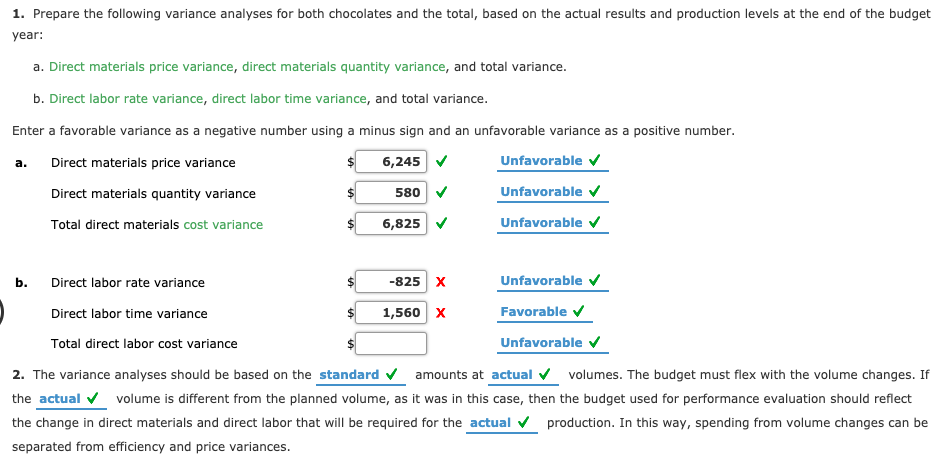Flexible Budgeting and Variance Analysis I Love My Chocolate Company makes dark chocolate and light chocolate. Both products require cocoa and sugar. The following planning information has been made available:?




Standard Price per Pound Cocoa Standard Amount per Case Dark Chocolate Light Chocolate 12 lbs. 9 lbs. 10 lbs. 14 lbs. 0.4 hr. 0.5 hr. $4.70 Sugar 0.60 Standard labor time Dark Chocolate Light Chocolate Planned production 5,500 cases 10,900 cases Standard labor rate $16.50 per hr. $16.50 per hr. I Love My Chocolate Company does not expect there to be any beginning or ending inventories of cocoa or sugar. At the end of the budget year, I Love My Chocolate Company had the following actual results: Dark Chocolate Light Chocolate Actual production (cases) 5,200 11,300 Actual Price per Pound Actual Pounds Purchased and Used Cocoa $4.80 164,900 Sugar 0.55 204,900 Actual Labor Rate Actual Labor Hours Used Dark chocolate $16.10 per hr. 1,890 Light chocolate 16.90 per hr. 5,790 Required: 1. Prepare the following variance analyses for both chocolates and the total, based on the actual results and production levels at the end of the budget year: a. Direct materials price variance, direct materials quantity variance, and total variance. b. Direct labor rate variance, direct labor time variance, and total variance. a. Enter a favorable variance as a negative number using a minus sign and an unfavorable variance as a positive number. Direct materials price variance 6,245 Unfavorable Direct materials quantity variance 580 Unfavorable Total direct materials cost variance 6,825 Unfavorable b. Direct labor rate variance -825 x Unfavorable Direct labor time variance 1,560 x Favorable Total direct labor cost variance Unfavorable 2. The variance analyses should be based on the standard amounts at actual volumes. The budget must flex with the volume changes. If the actual volume is different from the planned volume, as it was in this case, then the budget used for performance evaluation should reflect the change in direct materials and direct labor that will be required for the actual production. In this way, spending from volume changes can be separated from efficiency and price variances. Direct Materials and Direct Labor Variance Analysis Shasta Fixture Company manufactures faucets in a small manufacturing facility. The faucets are made from brass. Manufacturing has 40 employees. Each employee presently provides 32 hours of labor per week. Information about a production week is as follows: Standard wage per hour $13.20 Standard labor time per unit 15 min. Standard number of lbs. of brass 1.2 lbs. Standard price per lb. of brass $9.25 Actual price per lb. of brass $9.50 Actual lbs. of brass used during the week 8,158 lbs Number of units produced during the week 6,600 Actual wage per hour $13.60 Actual hours for the week (40 employees x 32 hours) 1,280 Required: a. Determine the standard cost per unit for direct materials and direct labor. Round the cost per unit to two decimal places. Direct materials standard cost per unit 11.1 Direct labor standard cost per unit Total standard cost per unit b. Determine the direct materials price variance, direct materials quantity variance, and total direct materials cost variance. Round your answers to the nearest whole dollar. Enter a favorable variance as a negative number using a minus sign and an unfavorable variance as a positive number. Direct Materials Price Variance Unfavorable Direct Materials Quantity Variance Unfavorable Total Direct Materials Cost Variance Unfavorable c. Determine the direct labor rate variance, direct labor time variance, and total direct labor cost variance. Round your answers to the nearest whole dollar. Enter a favorable variance as a negative number using a minus sign and an unfavorable variance as a positive number. Direct Labor Rate Variance Unfavorable Direct Labor Time Variance Favorable Total Direct Labor Cost Variance Favorable










